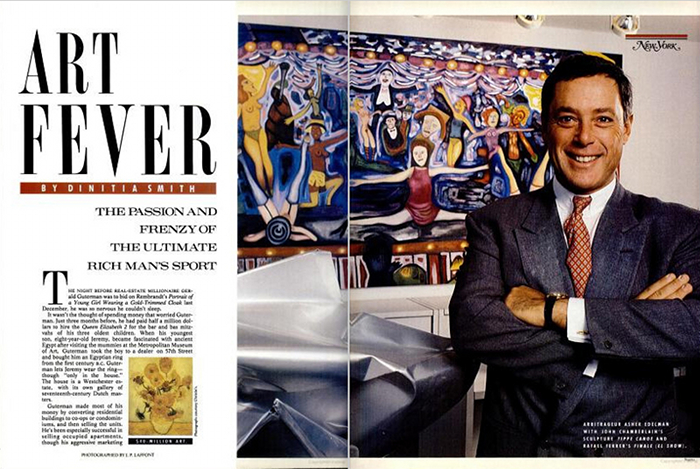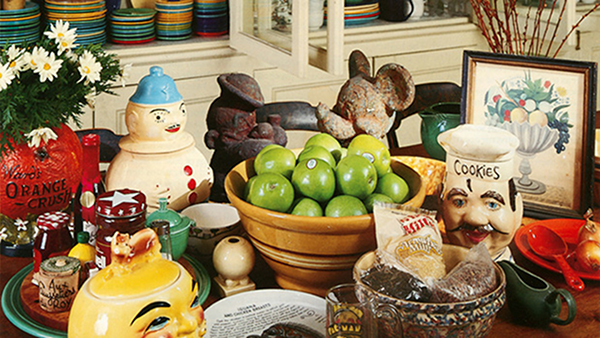The Fever Peaks
Cashing In: Art as a Commodity
Thursday, October 26, 1989
Baruch College, New York
In April 1987, New York magazine ran a story on “Art Fever,” picturing socialite art collectors on the cover and evoking the hum of art rapidly transmuting into gold in the text. By 1989 the business press was routinely showing graphs that proved the superiority of art over stocks as long-term investments, and art-talk events across the land took on the flavor of “Cashing In” (a panel held, please note, at a business college). Apparently only artists not cashing in (the majority) and museums priced out of the market failed to celebrate.
This panel discussion may have been one of the last such celebrations. By spring of 1990, art auctions at Sotheby’s and Christie’s had dropped to half their expected totals, and a work by Julian Schnabel had gotten no bid at all—to the delight of the audience, which laughed and applauded as it had formerly applauded megaprices (though whether that had been in praise of itself, the buyer, or just expensive art was never clear). By January 20, 1991, the situation was so acute that the New York Times Magazine made it the subject of a feature story, “SoHo Stares at Hard Times.” As author James Servin pointed out, with the financial world reeling from ills that ranged from the S & L crisis to the falling dollar, there was an “erosion of confidence” and “the art market unraveled with astonishing speed.” The newly “dire economic climate,” he said, brought gallery closings, consolidations, layoffs, lowered prices, and a roster of painful “adjustments.” It may also have brought, besides comfort to artists who had failed to cash in, a new topic for panels in business colleges and [for] articles in the business press—although not noticeably as of this writing.
Moderator: Gail Levin, art historian and professor at Baruch
Panelists: Roslyn Bernstein, professor of English and journalism at Baruch; Jeffrey Brosk, artist; Jeff Koons, artist; Hilton Kramer, critic; Suzanne Lemakis and Jennifer Vorbach, curators of Citibank collection
Roslyn Bernstein argued that paintings had always been appreciated for their trading potential, not their aesthetic value, but that art is now a major item in the financial pages of the business and general press. For example, the Business Periodical Index for 1984–85 had twenty articles on art, five of them specifically about art as investment. The 1986 Index showed a 30 percent jump in articles on art in every kind of business magazine, including the American Economic Review. By 1987, the number had increased to forty, under various “Art” subheadings, including thirteen articles just on art as investment. These included “Is the Art Market About to Peak?,” several analyses of why the stock market crash (October 1987) didn’t affect the art market, and even an investor’s “Post-Crash Portfolio” in Contemporanea, an art magazine, which encouraged investors to reach for certified bargains in art.1 From June 1988 to July 1989 there were fifty articles on art as investment, including several a week in the Wall Street Journal, many of them with detailed information on auction prices.
Interviewing a writer at Business Week about that publication’s interest in the art market, Bernstein was told it was because “art follows money.” Business Week also pointed out that auction houses, recognizing the importance of media, now pay more attention to journalists, entertaining them at lunch and so forth. The source saw the Warhol auction as a turning point. “Reporters may not know a Matisse from a Picasso but they know all the players.” Important collectors from business and society are well known to readers as well. Business press coverage of art made it respectable, gave it “credibility.” It also fueled sales, convincing investors to buy. A writer at Fortune said that magazine is concerned with management and art is not high on their interest list, but New York Magazine launched a new feature last year: a “Best Bids” column that reports on the auction scene and advises what’s hot.
Jennifer Vorbach described a collector who five years ago didn’t know the names Warhol or Picasso and is now an art dealer. She asked “When does your knowledge of its value interfere with your pleasure in living with the art?” and showed examples of paintings that presumably illustrated this conflict. However, the relation between the question and her examples was dubious. She added that interviews and articles about auctions of famous art rarely cite a profit motive. Heirs often sell to pay taxes or divide assets. She also noted that, if one compares the entire art business of about 20 billion dollars annually to the insurance business, which is probably in the hundreds of billions, art seems [to be] a relatively small world. However, Vorbach concluded that art is a “commodity with a difference—which makes all the difference.”
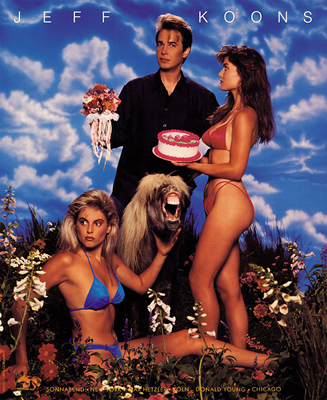
An advertisement for a Jeff Koons exhibition in the November 1988 issue of Art in America (artwork © Jeff Koons)
Jeff Koons said he hears a lot of talk about commodification of art, but he himself has never tried to commodify his art. In spite of some guffaws from the audience, he explained, “I work with materialism to meet the needs of people and to communicate ideas. Art has not been as great a commodifier as other industries.” Then he added, somewhat opaquely, “Art is an undefined profession; the capital base can be made into something new by artists.” Koons disclaimed any cynical gesture, maintaining that he keeps his “prices strong so they will be taken as politically serious statements.”
Hilton Kramer’s premise was that the craze to collect art resulted from so many other pleasures being forbidden: “Life has become austere and collecting art is one of the few things you can’t die from. Artists have always exchanged their work for money—it didn’t become a commodity fifteen minutes ago. And it really wasn’t better when artists were starving. The only difference is that today people ignorant about art are spending money on it.”
When Kramer wrote his column for the Sunday New York Times, the paper had 1.6 million readers, but he claimed perhaps only two hundred to three hundred people read his articles, adding that “the number or people now knowing about art is probably not much larger.” Today, he said, “We no longer have commanding figures in art, people under sixty who create a standard and provide a kind of leadership. In the absence of leaders there’s a chaotic situation.” In the 1980s, “the two most fretful issues are politics and money. Artists addressing political issues in their work are making a lot of money. (What other society would take Leon Golub seriously?) Money is now the principle substitute for art.”
Kramer doesn’t “begrudge people spending large sums of money on art, because what else have they got? They have meager lives and writing checks is their religion. Artists who induce themselves to believe they are satirists of the commodification of art have also joined the flock of people who don’t know anything about art except how to receive checks for it.” Kramer concluded, “Let’s sit back and watch the carnival go by.”
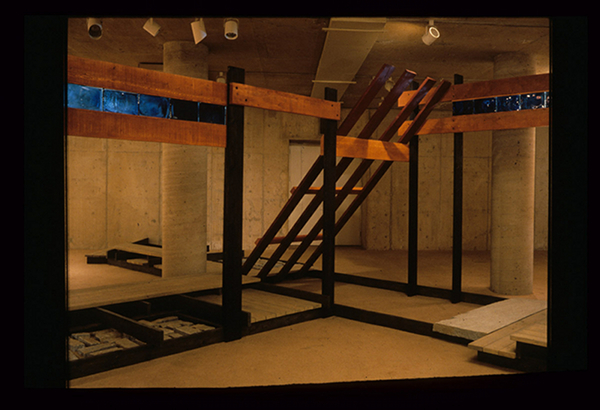
Installation view of Jeffery Brosk: Prairie Dance, held January 31–March 20, 1987, at the University of Massachusetts, Amherst
Jeffrey Brosk said there is a stratum of artists working with major issues whose work is overlooked by the press. He, for instance, makes works for specific sites that are usually demolished after three months. He looks at his art as a process: whether the piece remains or is destroyed, he learns from each and carries the information on to the next. (He has also done some permanent pieces.) Brosk didn’t make any direct contribution to the subject at hand, unless the non-saleability (and by extension, non-commodification) of his work was intended to be relevant.
Suzanne Lemakis buys art for a corporation she omitted to name but described as conservative. [Subsequent inquiry established it as Citibank.] She said businessmen, “the philistines,” would like to know more about art, but [they] also impose restrictions on her buying. For instance, she “can’t have anything in the collection that would either offend or require high maintenance.” The function of corporate art, Lemakis said, is to “please the troops; to make everyone happy in their offices and public rooms.” Corporations started collecting art to advertise their businesses. “Even in the 1930s, corporations commissioned artists and [supported] the arts,” she pointed out, citing IBM’s start in 1939. “When abstract art became American in the ’50s and ’60s, it, too, became acceptable.” Corporations don’t buy as a hedge or as investment, and they never buy “on the cutting edge…. In fact, when works of art in a corporate collection become very valuable, they create a problem in insurance and protection.”
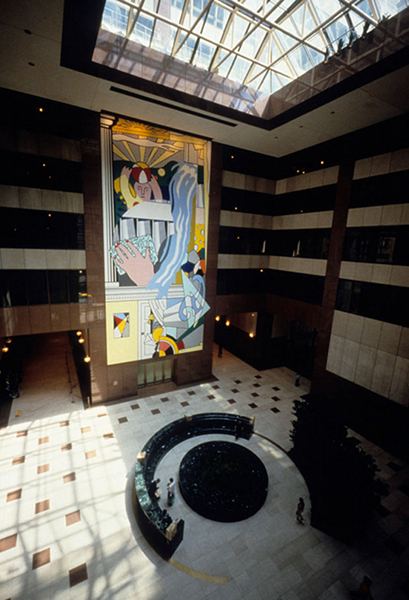
Roy Litchenstein, Mural with Blue Brushstroke, 1986, Magna on canvas, 68 ft. ¾ in. x 32 ft. 5¾ in. Installed in the AXA Equitable Building in New York (artwork © Roy Litchenstein Foundation; photographer not known)
In response, Kramer commented that “when a work of art goes into a corporate collection it’s taken out of circulation.” Lemakis replied that a good corporate collector lends work to museums. (Considering the preponderance of safe prints in her corporation’s collection, there may not be much demand.) Kramer also complained that the Roy Lichtenstein [mural] commissioned for the Equitable Building lobby was like an advertisement for Lichtenstein. Jennifer Vorbach added that it was a safe choice, part of the “buy-another-Stella syndrome.”
Moderator Gail Levin quoted dealer Phyllis Kind’s opinion that we are going through a fin de siècle decadent time, that artists are making things for the commodifiers to buy. Jeff Koons asserted that he did not believe art is “bankrupt” and that the artist will continue to be a communicator. Jeffrey Brosk said art is reflective of the times—pop music, architecture, etc., are all associated with money. Kramer disagreed with the end-of-century theory but wished we were at the end of the nineteenth century instead. “What’s going on in the art world has everything to do with the world economic situation,” he said. “In the last decade there has been a tremendous increase in wealth. Art has entered the area of popular investment.”
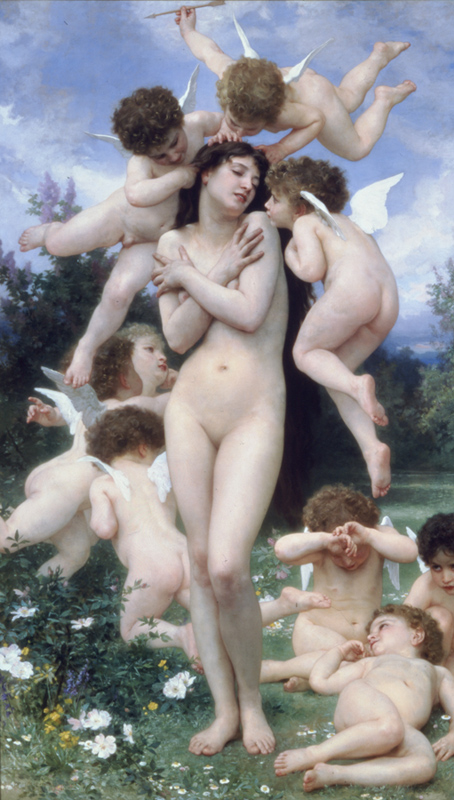
William-Adolphe Bouguereau, The Return of Spring, 1886, oil on canvas, 84½ x 50 in. (artwork in the public domain)
Bernstein pointed out that not so long ago there were two hundred art galleries in New York; now there are over six hundred, many of them tax write-offs or vanity galleries. Kramer reminded the audience that “in 1890 people weren’t buying Cézanne—he had only one show—but were buying Gérôme and Bouguereau.” And, he added, they’re “now buying them again. Garbage then and garbage now.” Today, “the economic system produces people who can’t read or write. They’ve substituted an attachment to the visual.”
Levin asked Koons why he doesn’t make editions of one hundred instead of his usual three. Koons said it would “reduce the seriousness of the art.” Besides, “if something is rare it’s a more sexual experience.”
On the topic of price in contemporary art, Kramer said there are many distinctive works on the market for $2,000 and under—drawings, for instance. He recalled a panel some thirty years ago, in 1958, when “a dealer said, ‘today one can’t buy a work of art for under $1,000’ and the audience gasped.” Brosk recommended that for real values collectors should look at slide files of artists not represented in galleries.
When a member of the audience said to Koons, “You said you paint for the needs of people. I thought an artist painted for himself,” Koons responded incoherently. Kramer pointed out that the press plays a significant role in the dynamics of the market, especially the auction market. He had tried to persuade the Times not to run auction news on the front page, but failed. Someone addressed Kramer’s claim that there are no modern masters, suggesting that because contemporary artists now cash in early, they fail to develop. Kramer replied, “we’ve become a valueless society—this is a time of crisis.”
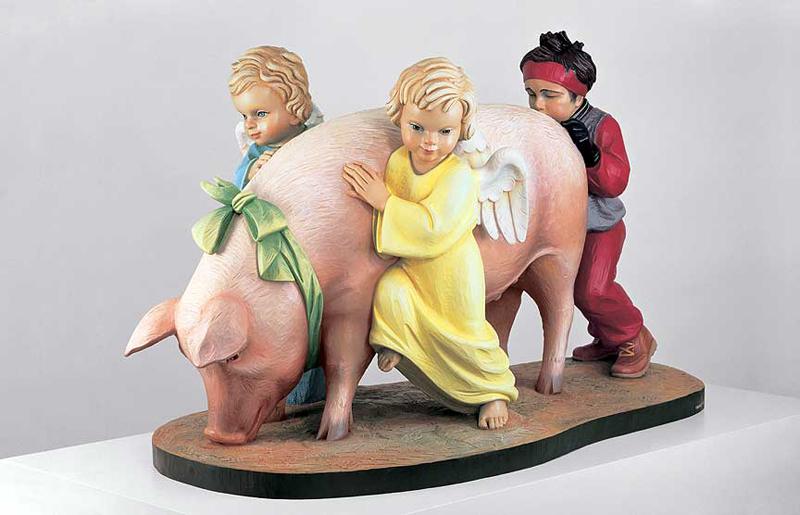
Jeff Koons, Ushering in Banality, 1988, polychromed wood, 38 x 62 x 30 in. (artwork © Jeff Koons; photographer not known)
The event had begun with a huge audience, but as it played itself out, discussion degenerated into trivialities and wrangling, with most “questions” (or accusations) directed at Koons. People started to leave and soon we did too. Still, as telling as any comment this panel could have made, was the fact that, less than three weeks later, auction news drove world events off the front pages.
In a twelve-day period, art sales exceeded a billion dollars. There were sales totaling $232 million one night and $270 million the next. Among other records, some 124 works—Impressionist and Modern—sold for more than $10 million each, and close to 150 works sold for more than $1 million each. An auction house spokesperson said, “the art market is alive and well … and even more solid than six months ago.”
In Terms Of count: unknown.
Update: In 1991, Jennifer Vorbach, now a vice president of Citibank’s “art advisory service” (i.e., the department that lends money for investment in art), told a reporter that the number of requests for credit had gone from more than ten a week in 1989 to “maybe two” in 1991, “but from more financially solid people.” Other investment bankers reported that “the speculators who drove up art prices in the ’80s have run far away,” and modern art currently “makes most bankers queasy.” Few are willing to lend for art at all, and Japanese investors have almost completely left the market (although one broker said he’d still rather “lend against a diversified collection than a Park Avenue co-op”). Prices for decorative arts have apparently held up, but right now, far and away the most profitable “art” investment is baseball cards. [New York Times, November 22, 1991]
1 Contemporanea ceased publishing in 1990.
Source
Written by Cynthia Navaretta, “The Fever Peaks” was originally published in Women Artists News 14, no. 4 (Winter 1989/90); and reprinted in Judy Seigel, ed., Mutiny and the Mainstream: Talk That Changed Art, 1975–1990 (New York: Midmarch Arts Press, 1992), 296–98. In Terms Of thanks Midmarch Arts Press for permission to republish this review.


